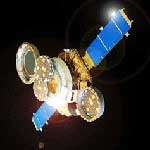NASA Hopes to Recover Data from Genesis Capsule

The Genesis sample return capsule entered Earth's atmosphere at 9:52:47 a.m. MDT and entered the preplanned entry ellipse in the Utah Test and Training Range as predicted. However, the Genesis capsule, as a result of its parachute not deploying, impacted the ground at a speed of 311 kilometers per hour (193 mph). The impact occurred near Granite Peak on a remote portion of the range. No people or structures were anywhere near the area.
"For the velocity of the impact, I thought there was surprisingly little damage," said Roy Haggard of Vertigo Inc., Lake Elsinore, Calif., who took part in the initial reconnaissance of the capsule. "I observed the capsule penetrated the soil about 50 percent of its diameter. The shell had been breached about three inches and I could see the science canister inside and that also appeared to have a small breach," he said.
The science canister from the Genesis mission was moved into the cleanroom at the U.S. Army Dugway Proving Ground in Utah early Wednesday evening. First, a team of specialists plucked pieces of dirt and mud that had lodged in the canister after the mission's sample return capsule landed at high speed in the Utah desert. The Genesis team will begin examining the contents of the canister on Thursday morning.
The Genesis mission was launched in August 2001 on a journey to capture samples from the storehouse of 99 percent of all the material in our solar system -- the sun. The samples of solar wind particles, collected on ultra-pure wafers of gold, sapphire, silicon and diamond were designed to be returned for analysis by Earth-bound scientists.

















